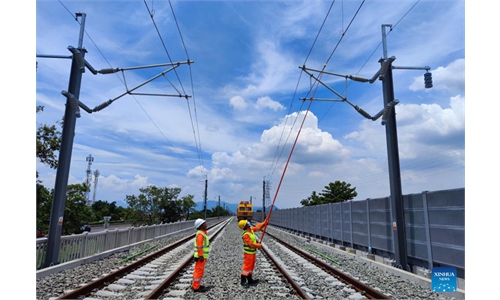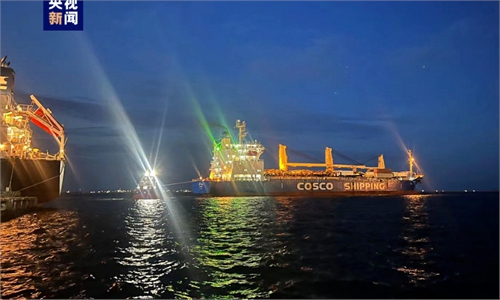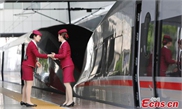
Illustration: Chen Xia/Global Times
China has been making meteoric progress in upgrading the nation's transportation infrastructure, driven by its indigenous development of technologies to advance smarter travel and mobility efficiency, although the emergence of COVID-19 has to some extent negatively impacted the speed of industry innovations over the past three years.In 2016, with the completion of the country's so-called "four-plus-four" high-speed railway grid,a massive middle-to-long term high-speed railway network plan was drafted, which envisioned a larger "eight-plus-eight" horizontal and vertical high-speed railway network crisscrossing China's huge landscape, linking more than 90 percent of the country's first- and second-tier cities.
Meanwhile, construction of intercity fast rail transit systems serving the country's major economic hubs, centering Beijing, Shanghai, Shenzhen and Guangzhou, as well as Chongqing and Chengdu, have been intensified to facilitate the integration and development of large metropolitan regions in the country. The proposed "eight-plus-eight" high-speed railway network will be completed in 2030, when the total length of China's high-speed railway system will surpass 60,000 kilometers, media reports said.
According to one ancient Chinese proverb, if a region aspires to become prosperous, it needs to build roads first, which explains the importance of constructing express roads. high-speed railway lines are able to provide fast, reliable and comfortable means of transporting large numbers of passengers in a densely populated nation like China, and, over long distances.
Meanwhile, the previous long network of rail tracks shared by passenger and freight trains has been used now to solely move freight trains, which greatly improves freight transport efficiency in the country, significantly contributing to its progress of business environment .
Being rated as "one of the world's safest transportation systems", China's high-speed railway construction has made the nation a leading source of domestically developed high-speed rail building technologies in the world.
The country now leads in delivering the next generation of high-speed train systems by developing a local capability to produce top-caliber and high-quality components just by itself.
Running mostly at 350 kilometers per hour, the high-speed railway network has significantly helped improve China's economic productivity and manufacturing sector competitiveness over the long term by upgrading the transport capacity of railways, which are broadly linking with the country's scattered labor markets.
Chinese economists have hailed the high-speed railway system in enhancing cross-city economic and technological integration, and promote economic development of China's hinterland and outlying western provinces, by bringing about prosperity to many second- and third-tier cities in a short period of time. Environmentalists also praise the high-speed rail network, because it supports energy independence and ecological sustainability. Electric trains use less energy to transport passengers on a per unit basis and can draw power from more diverse sources of energy, including renewable energies.
And in time of economic downturns like the 2008-09 global financial crisis, the Chinese government's pivot to allocate a significant budget to high-speed railway construction was a highly effective form of economic stimulus, as high-speed railway construction creates many jobs and drives up demand for steel, cement and other building materials.
With regard to China's national expressway network construction, the National Trunk Highway System (NTHS) is composed of a grid of seven radial expressways from the capital city of Beijing, 11 north-south expressways and 18 east-west expressways, which is also nicknamed the "71118" network. At the end of 2021, the total length of the country's expressway network had reached 166,000 kilometers, Xinhua News Agency reported.
To ramp up intra-city commute conditions, China is now vigorously researching and developing a digitalized smart road system in cities like Wuxi in Jiangsu Province and Hangzhou in Zhejiang Province. Aided by Huawei's advanced 5G innovations, the two cities are deploying a network of connected sensors and big data-reinforced AI technology to help command and navigate running cars on streets. Now driving in the cities, it's easy to get traffic alerts such as congestion streets, blind-zone warnings and speed limits - all elements of intelligent roads providing for fast, smooth, and disentangled traffic.
While car manufacturers cannot build smart roads, local governments can. Since 2018, the city of Wuxi has chartered its own direction based on local conditions, beginning with building new infrastructure so that smart roads can support internet-connected smart cars. Now more than 450 square kilometers in Wuxi city are deployed with communication sensors which interact with internet-connected cars. Now, as more car makers accelerate vehicle-road collaboration and vehicle intelligence, a growing number of Chinese cities are expected to witness the steady growth in internet vehicles and autonomous driving service innovations, according to industry experts.
In a nutshell, China has been at the forefront of global road transport sector innovation over the past 20 years, which also explains why it boasts one of the world's best transportation infrastructure networks. It is expected that China will continue to ratchet up investment to remain ahead when it comes to innovation in the sector, and at the same time, under the guidance of Belt and Road Initiative, assist other friendly countries to boost infrastructure and improve their economic connectivity while create more opportunities for local people.
The author is an editor with the Global Times. bizopinion@globaltimes.com.cn



